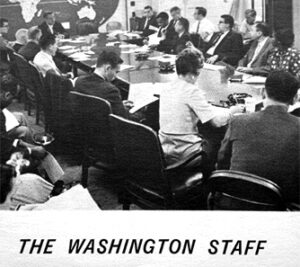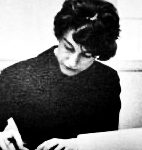The Peace Corps On Day One: Women And The Mad Men At HQ
Arriving for work on or before March 1, 1961, the day President Kennedy signed the executive order establishing the Peace Corps, were a few women who were early “volunteer staffers” and who would become famous in those first years of the agency. The majority of these women were well connected by family or friends to Shriver and eager to work at the Peace Corps, the shining star of Kennedy’s administration.
The Peace Corps was the ‘hot’ agency and everyone, of course, wanted to be connected to Kennedy–if they couldn’t be in the White House–they wanted to be with Shriver and the Peace Corps.
The women at the time were mostly ‘second class’ citizens in the world-of-work. They were not, for example, sitting at the ‘big conference table” at Senior Staff meetings.
Looking at old black-and-photos of Peace Corps HQ meetings, you might see that Elizabeth (Betty) Forsling Harris had wedged herself into the group, but that was Betty at her best and few others had her Texas toughness.
In these old photos, most of the women are in chairs shoved back up against the walls, sitting behind the men and waiting to be called upon for some piece of information that the men had forgotten. There, of course, against the walls and watching the boys at play, they would amuse themselves by observing all of the Super Egos trying to impress Shriver. Looking at these old black-and-white photos one is struck by two things: 1) everyone is smoking; 2) few women at the conference table. It could have been a scene from the Mad Men T.V. show. The late Jane Campbell Beaven, who worked in the Division of Volunteer Support, and later APCD in Ethiopia before going onto UNICEF, tells of observing the Senior Staff scribbling notes on yellow legal pads and frantically slipping them back and forth across the wide waxed conference tables. “They reminded me,” she recalls, “of little third grade boys passing notes behind the teacher’s back.”
The Women Up Against the Wall, however, were powerful in their own right. Some of the noted female staffers were: Maryann Orlando, Sally Bowles, Nancy Gore, Nan McEvoy, Diana MacArthur, Patricia Sullivan, Alice Gilbert,, Ruth Olson, Dorothy Mead Jacobsen.
Several women, particularly Betty Harris and Sally Bowles, heavily influenced agency decisions, especially decisions about the role of women in the Peace Corps. Sally Bowles, for example, would play a silent, and very important role, in advising Sarge. At the time, she was only around twenty-three-years old. Betty Harris would play a large role on the whole role of what would the agency do with the PCVs who became pregnant in the Peace Corps.
Here are quick profiles of some of these women staffers.
Mary Ann Orlando is the one person Sarge brought with him when he left Chicago for the Peace Corps. She was born and raised in Chicago, and went to work at the vast Merchandise Mart in 1946. When Shriver arrived in 1948 to take charge of the Mart, Mary Ann became his secretary and at the start of the Peace Corps had already worked for him for 13 years. Her title at the Peace Corps was Confidential Assistant to the Director. Mary Ann would go with Shriver to OEO, and then later into his private practice. No one–and I mean no one–could get to Shriver in his office unless they could talk their way around Mary Ann Orlando.
Al Gore has said on a few occasions that his older sister, Nancy Gore, was a Peace Corps Volunteer. While Nancy Gore did have a Peace Corps history, she was never a Volunteer. Nancy was the daughter of Tennessee Senator Albert Gore. She had graduated from Vanderbilt with a degree in history, and had also studied in Monterrey, Mexico, Caen, France, and the Sorbonne. She was a guide at the Brussels World Fair in ’58, and had travelled in Europe and Asia. Also, as a senator’s daughter, she had worked for the Democratic National Committee, and in the early days of the Peace Corps she had the title of assistant to the Associate Director for Planning and Evaluation, Bill Haddad, who would go onto run for Congress in New York State. [Nancy would later become Bill Moyers’ assistant.] At the time Nancy was “dating” [as we said at the time] David Halberstam, who was then writing for The New York Times. In the building at 806 Connecticut Avenue, she was known as the “resident Scarlett O’Hara.” Beautiful Nancy was one of the first twelve people working at HQ in March 1961. She would die in 1984 at the age of 46 of lung cancer.
Working with Nancy, sharing an office, was another ‘famous daughter,” Sally Bowles. Sally was the daughter of Ambassador Chester Bowles. She was an honor graduate in history from Smith College where she was editor of the college newspaper and president of the student body. She has traveled and lived in Southeast Asia, India, Mexico, Morocco, France and Spain. She served as legislative assistant to Congressman John Brademas, and as administrative assistant to Solicitor General Archibald Cox. She arrived for work at the Peace Corps on March 1, 1961, and went to work as a Volunteer Liaison Officer in the Division of Volunteer Field Services. Beyond this title, Sarge often called on Sally to make special trips overseas for him, to advise him on the performance of overseas Rep. [Other women in those years would work around official channels to get to Sarge. I remember in Ethiopia how Jane Campbell wrote a personal letter to Sarge in 1965 and asked Sarge to ‘overrule’ a Peace Corps Directive on behalf of an Ethiopian PCV. Sarge did.]
Bluestocking Nan Tucker McEvoy, Deputy Director of Africa Program, was a reporter who had covered state politics in California, national politics in Washington and international conferences and events during ten years with The San Francisco Chronicle, The New York Herald Tribune and the Washington Post. Her grandfather, Michael de Young, founded the San Francisco Chronicle in 1865. As the only child of Phyllis de Young Tucker, she inherited one-third ownership of the Chronicle Publishing Company and headed the board from 1981 to 1995. Later, she owned a 550-acre ranch in California and is the largest producer of organic estate-grown olive oil in the nation.
There was also the famous West Africa desk officer who Peace Corps Evaluator Fletcher Knebel captured wonderfully in his 1966 novel on the Peace Corps, The Zinzin Road.
Knebel called his character Maureen Sutherland, “…a slim, willowy young woman, stylishly dressed….She wore elongated dark glasses, and a sheaf of black hair fell loosely over one eye. Her skin, as creamy as enameled china, hinted of regular facials and a variety of expensive oils and ointments.”
Sutherland was based exactly on a legendary Africa Region desk officer. She was famous for flying into West Africa for a brief, whirlwind fact-finding trip, which she breezily referred to as a ‘look/see.’
Knebel describes his PC/W official on a visit to Africa–“Miss Sutherland lilted on for half an hour, festively dropping names from Lagos to Washington…she gave a glittering panorama of the world of great affairs, its intrigues, its grand policies and even its illicit loves…She concluded on a pitch of finishing-school breathlessness and looked about brightly as thought waiting for applause.”
All true. But she was a good desk office. She would late in the day go down to the Selection Office and pull the files and look through the applicants and pick the PCVs she wanted for West Africa. Those were the days when as an Overseas Rep you needed a Desk Officer who could work the Selection system if you wanted the best PCVs. Believe me, she could work the system. Among the Man Men of the Peace Corps, she held her own, and beat them at their game of passing notes across the wide waxed conference table, and she did it right under Shriver’s nose.





good old Al Gore, fast and loose with the facts as usual. didn’t he invent the internet or something?
Al Gore has said on a few occasions that his older sister, Nancy Gore, was a Peace Corps Volunteer. While Nancy Gore did have a Peace Corps history, she was never a Volunteer.